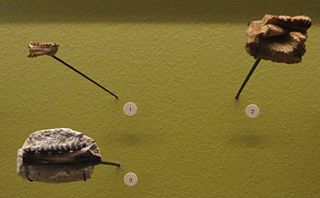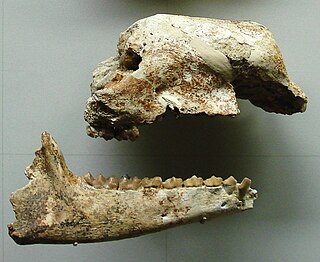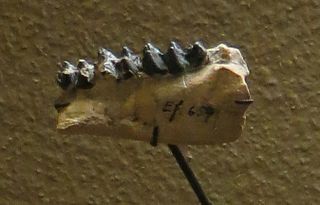
Anoplotherium is the type genus of the extinct Palaeogene artiodactyl family Anoplotheriidae, which was endemic to Western Europe. It lived from the Late Eocene to the earliest Oligocene. It was the fifth fossil mammal genus to be described with official taxonomic authority, with a history extending back to 1804 when its fossils from Montmartre in Paris, France were first described by the French naturalist Georges Cuvier. Discoveries of incomplete skeletons of A. commune in 1807 led Cuvier to thoroughly describe unusual features for which there are no modern analogues. His drawn skeletal and muscle reconstructions of A. commune in 1812 were amongst the first instances of anatomical reconstructions based on fossil evidence. Cuvier's contributions to palaeontology based on his works on the genus were revolutionary for the field, not only proving the developing ideas of extinction and ecological succession but also paving the way for subfields such as palaeoneurology. Today, there are four known species.

Xiphodontidae is an extinct family of herbivorous even-toed ungulates, endemic to Europe during the Eocene 40.4—33.9 million years ago, existing for about 7.5 million years. Paraxiphodon suggests that they survived into the Lower Oligocene, at least.

Anoplotheriidae is an extinct family of artiodactyl ungulates. They were endemic to Europe during the Eocene and Oligocene epochs about 44—30 million years ago. Its name is derived from the Ancient Greek: ἂνοπλος ("unarmed") and θήριον ("beast"), translating as "unarmed beast".
Duerotherium is an extinct genus of artiodactyl that lived during the Middle Eocene and is only known from the Iberian Peninsula. The genus is a member of the family Anoplotheriidae and the subfamily Anoplotheriinae, and contains one species, D. sudrei. Like other anoplotheriids, it was endemic to Western Europe. The genus was described based on a left fragment of a maxilla from the Mazaterón Formation of the Duero Basin, from which its name derives, in 2009. Its dentition is mostly typical of the Anoplotheriinae but differs from related genera in the elongated and triangular third upper premolar and traits of the molars. It is thought to have been part of an endemic fauna that evolved in the Iberian Peninsula during the Middle Eocene, when climates were subtropical.

Xiphodon is the type genus of the extinct Palaeogene artiodactyl family Xiphodontidae. It, like other xiphodonts, was endemic to Western Europe and lived from the Middle Eocene up to the earliest Oligocene. Fossils from Montmartre in Paris, France that belonged to X. gracilis were first described by the French naturalist Georges Cuvier in 1804. Although he assigned the species to Anoplotherium, he recognized that it differed from A. commune by its dentition and limb bones, later moving it to its own subgenus in 1822. Xiphodon was promoted to genus rank by other naturalists in later decades. It is today defined by the type species X. gracilis and two other species, X. castrensis and X. intermedium.

Cainotheriidae is an extinct family of artiodactyls known from the Late Eocene to Middle Miocene of Europe. They are mostly found preserved in karstic deposits.
The Quercy Phosphorites Formation is a geologic formation and lagerstätte in Occitanie, southern France. It preserves fossils dated to the Paleogene period, or MP16 to MP28 zones of the European land mammal age classification, ranging from approximately 38 to 25 Ma.

Dichodon is an extinct genus of Palaeogene artiodactyls belonging to the family Xiphodontidae. It was endemic to Western Europe and lived from the middle Eocene up to the earliest Oligocene. The genus was first erected by the British naturalist Richard Owen in 1848 based on dental remains from the fossil beds in Hordle, England. He noticed similar dentitions to contemporary artiodactyls like those of the Anoplotheriidae and Dichobunidae and references the name of the genus Dichobune. Eventually, it was found to be more closely related to Xiphodon and now includes 11 species, although one of them may be synonymous.

Bachitherium is an extinct genus of Paleogene ruminants that lived in Europe from the late Eocene to the late Oligocene. The genus was erected in 1882 by Henri Filhol based on fossil remains found in the Quercy Phosphorites Formation. Bachitherium curtum was defined the type species, and another species called B. insigne; five more species have since been named although one, B. sardus, is currently pending reassessment. The genus name derives from "Bach", the French locality where its first fossils were found, and the Greek θήρ/therium meaning "beast". Bachitherium has historically been assigned to various families within the ruminant infrorder Tragulina, but was reclassified to its own monotypic family Bachitheriidae by Christine Janis in 1987.

Diplobune is an extinct genus of Palaeogene artiodactyls belonging to the family Anoplotheriidae. It was endemic to Europe and lived from the late Eocene to the early Oligocene. The genus was first erected as a subgenus of Dichobune by Ludwig Rütimeyer in 1862 based on his hypothesis of the taxon being a transitional form between "Anoplotherium" secundaria, previously erected by Georges Cuvier in 1822, and Dichobune. He based the genus etymology off of the two-pointed pillarlike shapes of the lower molars, which had since been a diagnosis of it. However, in 1870, Diplobune was elevated to genus rank by Oscar Fraas, who recognized that Diplobune was a distinct genus related to Anoplotherium and not Dichobune. After several revisions of the anoplotheriids, there are currently four known species of which D. minor is the type species.

Dacrytherium is an extinct genus of Palaeogene artiodactyls belonging to the family Anoplotheriidae. It occurred from the Middle to Late Eocene of Western Europe and is the type genus of the subfamily Dacrytheriinae, the older of the two anoplotheriid subfamilies. Dacrytherium was first erected in 1876 by the French palaeontologist Henri Filhol, who recognised in his studies that it had dentition similar to the anoplotheriids Anoplotherium and Diplobune but differed from them by a deep preorbital fossa and a lacrimal fossa, the latter of which is where the genus name derives from. D. ovinum, originally classified in Dichobune, is the type species of Dacrytherium. Henri Filhol named D. elegans in 1884, and Hans Georg Stehlin named the species D. priscum and D. saturnini in 1910.

Catodontherium is an extinct genus of Palaeogene artiodactyls belonging to the family Anoplotheriidae. It was endemic to Western Europe and had a temporal range exclusive to the middle Eocene, although its earliest appearance depends on whether C. argentonicum is truly a species of Catodontherium. It was first named Catodus by the French palaeontologist Charles Depéret in 1906, who created two species for the genus and later changed the genus name to Catodontherium in 1908. The Swiss palaeontologist Hans Georg Stehlin renamed one species and classified two other newly erected species to Catodontherium in 1910. Today, there are four known species, although two remain questionable in genus placement.
Ephelcomenus is an extinct genus of Palaeogene artiodactyls belonging to the Anoplotheriidae that were endemic to Western Europe. It contains one species E. filholi, which was first described by Richard Lydekker in 1889 but eventually classified to its own genus by the Swiss palaeontologist Johannes Hürzeler in 1938. It has an uncertain stratigraphic range, but some sources suggest that it was present in the Oligocene after the Grande Coupure turnover event of western Europe.
Robiatherium is an extinct genus of Palaeogene artiodactyls containing one species R. cournovense. The genus name derives from the locality of Robiac in France where some of its fossil were described plus the Greek θήρ/therium meaning "beast" or "wild animal". It was known only from the middle Eocene and, like other anoplotheriids, was endemic to Western Europe. The genus was erected by Jean Sudre in 1988 for a species originally attributed to the xiphodont genus Paraxiphodon in 1978. Robiatherium had dentitions typical of the subfamily Anoplotheriinae, differing from other genera by specific differences in the molars. It is one of the earliest-appearing anoplotheriine species in the fossil record as well as the earliest to have appeared in Central Europe.

Mixtotherium is an extinct genus of Palaeogene artiodactyls belonging to the monotypic family Mixtotheriidae. Known informally as mixtotheriids or mixtotheres, these artiodactyls were endemic to western Europe and occurred from the middle to late Eocene. The genus and type species were both first established by the French naturalist Henri Filhol in 1880. Several species are well known by good skull fossils, which were informative enough to allow for classifications of the species to their own family. The Mixtotheriidae, first recognized by Helga Sharpe Pearson in 1927, is currently known by 7 valid species, although M. priscum is thought by several authors to be synonymous with M. gresslyi. The affinities of the Mixtotheriidae in relation to other artiodactyl families is uncertain, but it is currently thought to have been related to the Cainotherioidea and Anoplotheriidae.
Haplomeryx is an extinct genus of Palaeogene artiodactyls belonging to the family Xiphodontidae. It was endemic to Western Europe and lived from the Middle Eocene up to the earliest Oligocene. Haplomeryx was first established as a genus by the German naturalist Max Schlosser in 1886 based on a molar tooth set from Quercy Phosphorites deposits. Three additional species were erected and classified to the xiphodontid genus while one other species, first recognized in 1822, was tentatively classified to it and remains unresolved in affinity.

Amphimeryx is an extinct genus of Palaeogene artiodactyls belonging to the Amphimerycidae that was endemic to the central region of western Europe and lived from the Late Eocene to the Early Oligocene. It was erected in 1848 by the French palaeontologist Auguste Pomel, who argued that its dentition was roughly similar to those of ruminants. Hence, the etymology of the genus name means "near ruminant," of which it derives from the ancient Greek words ἀμφί (near) and μήρυξ (ruminant). The type species A. murinus was previously recognized as a species of Dichobune by the French palaeontologist Georges Cuvier in 1822 before its eventual reclassification to its own genus. Two other species A. collotarsus and A. riparius are recognized also today although the former may be synonymous with A. murinus while the latter is known solely by a now-lost fossil specimen.

Pseudamphimeryx is an extinct genus of Palaeogene artiodactyls belonging to the Amphimerycidae that was endemic to the central region of western Europe and lived from the Middle to Late Eocene. It was first erected in 1910 by the Swiss palaeontologist Hans Georg Stehlin, who assigned to it multiple species and noted specific differences from another amphimerycid Amphimeryx. As of present, it is known by six species, although the validity of P. valdensis has been questioned while the earliest-appearing species P. schosseri has been suggested to not be an amphimerycid.

Amphimerycidae is an extinct family of artiodactyls that was endemic to western Europe that lived from the Middle Eocene to the Early Oligocene. With a taxonomic history extending as far back as 1804, the family was formally recognized by the Swiss palaeontologist Hans Georg Stehlin in 1910 and contains two genera: Amphimeryx and Pseudamphimeryx. Both amphimerycid genera are very similar to each other in terms of skull and dental anatomy but do have specific differences from each other. Both genera are best known from their fused cuboid bone and navicular bone, which together make up a single "cubonavicular bone" of the hind legs. This trait had long been used in support of the idea that they were ruminants by taxonomists. However, their classification to the Ruminantia had also been rejected by other taxonomists later on due to differences in dentition; the systematic position of the Amphimerycidae and close relatives in relation to the wider Artiodactyla, as a result, is unclear.
Leptotheridium is an extinct genus of Palaeogene artiodactyl endemic to western Europe that lived from the Middle to Late Eocene. It was erected by the Swiss palaeontologist Hans Georg Stehlin in 1910 and contains the species L. lugeoni and L. traguloides. Its phylogenetic position is unclear, with researchers determining that it belonged to either the Anoplotheriidae or the Xiphodontidae due to its dental and postcranial anatomy. The small-sized artiodactyl genus is unique from its close relatives in that it seemingly lacks the first lower premolars, weak selenodonty in its dentition, and has three-lobed canines. It is one of the earlier artiodactyl species to have appeared in the fossil record of Europe.













